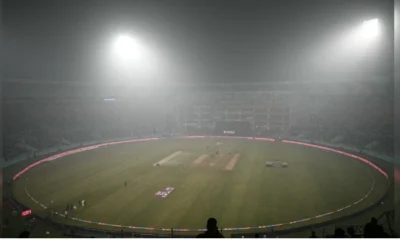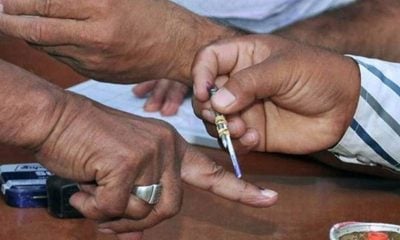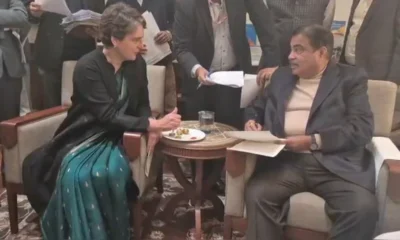[vc_row][vc_column][vc_column_text]Experts put heads together, pinpoint problem areas; say a long way to go before results begin to arrive
While the prime minister has been extolling the virtues of the Jan Dhan Yojana and Mudra Yojana at the Buenos Aires G20 summit, farmers are rallying in Delhi for a solution to their crises. They are demanding implementation of the MS Swaminathan Commission report. At this juncture, is it fair to claim that the present government’s schemes were successful at the domestic level?
Saturday’s edition of Mudda tried to answer this question, with Anant Tyagi leading a discussion among BJP spokesperson Dinesh Singh, Congress spokesperson Saif Khan, farmers’ activist Pushpendra Singh, academic Prof. Aman Agarwal, and Govind Pant Raju, senior journalist.
“The growth rate has been 7.1 percent, and 8.1 in the last quarter. The rupee is climbing. In the last one and one-and-a-half months, the RBI, too, has reached an agreement with the government to solve some issues,” said Dinesh Singh.
A 1.5 lakh crore loan waiver has been given to farmers every year. But agitating is like a drug to them. The GDP is still growing, albeit at a slower rate, said Agarwal.
Raju felt that Modi has been doing well to present his best foot forward at foreign summits. “China is a force in South China Sea. So this exercise is necessary. Just because Modi is good at naming schemes, the opposition calls him a jumlebaaz (tall talker),” he said.
Khan then said while China has a 14 trillion strong economy, its GDP contribution is 10 percent as compared to our 7.1 percent GDP growth rate. “Look at our agricultural growth rate, manufacturing growth rate, mining growth rate (which is at -2.4 percent from 6 percent). The economic secretary, Subhash Chandra, has himself termed the figures disappointing. The RBI, too, has admitted slow growth for the last four years. Today, the agricultural growth rate is 3.8 percent, down from 5.2 percent during the UPA tenure. This is the reason behind the massive number of farmer suicides,” he said.
Pushpendra Singh was affronted by Agarwal’s assertion that farmers had been given 1.5 lakh crore loan waivers each year. He maintained that a waiver of Rs 6,000 crore was given in 1990 and a total waiver of Rs 2.1 crore during the 10 years of UPA rule. “Yet it is the farmers who give the government grain at subsidised rates. The minimum support price (MSP) of rice is Rs 1,750 per quintal; it is Rs 2,500 in a country like Bangladesh. Agarwal should explain himself,” he said.
Raju held that the government did make its own efforts even if they proved unsuccessful.
Pushpendra Singh pointed out that according to calculations, MSP for rice should be Rs 2,340.
Agarwal asserted, “We floated the Kisan credit card. We also said we must take the mandi to the farmer. Only then will they be able to get a profitable price for their produce, and there will be less spoilage and pilferage.”
“Modi gave us the warehousing dream. It remains unfulfilled. Also, middlemen continue to rule the roost,” Raju then said.
Is the idea of an online system to sell produce in essence cheating the farmer, Anant asked. Most of them are illiterate and poverty-stricken, he reminded the audience.
Pushpendra Singh responded. “Only six percent of farmers benefit from MSP, that, too, from a limited set of produce, as is learnt from the 2015 Shanta Kumar Committee report. Every year, greens worth Rs 1 lakh crore is lost to spoilage. Yet there has been no improvement in the agricultural infrastructure in the last four years. Even if a farmer knows he will get a better price for his harvest in a state like, say, Haryana, he cannot travel there to sell it. He has to sell it in his nearest mandi like a bonded labourer. The proposals like an online mandi look good on paper, but look at the figures. Agricultural growth was at an abysmal 5.2 percent during the UPA’s tenure. Now it has fallen to 2.5 percent. Agriculture gross capital formation was 17.7 percent and now it is at 15.5. Agriculture trade sulplus has dropped from 26 million dollars to 14 million dollars. Despite all odds, our farmers did exceedingly well in pulses production in the last few years. Shockingly, the government went in for pulses import during this time. The result was that all their hard work went to waste and they could not sell them. It is the same with the milk producers. Does any thought go into our policies and measures?”
Pushpendra Singh then went on to raise two more points. He said that the crop insurance schemes need to be looked into. Also, MSP for sugarcane needs to be revised at the earliest as farmers, overburdened by inflation, have been selling the cane at the same price for many years now, and are badly in need of succour.
—Compiled by Sucheta Dasgupta
[/vc_column_text][/vc_column][/vc_row]


 India News23 hours ago
India News23 hours ago
 Cricket news23 hours ago
Cricket news23 hours ago
 India News23 hours ago
India News23 hours ago
 India News18 hours ago
India News18 hours ago
 India News18 hours ago
India News18 hours ago
 Latest world news18 hours ago
Latest world news18 hours ago
 Latest world news58 mins ago
Latest world news58 mins ago
 India News46 mins ago
India News46 mins ago













